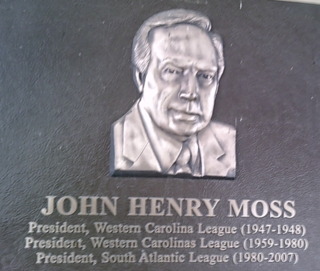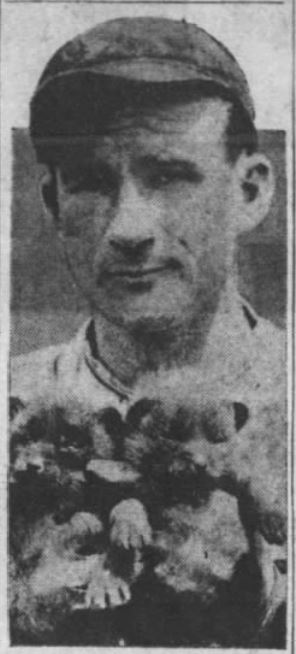
The South Atlantic League, often informally called the Sally League, is a Minor League Baseball league with teams predominantly in states along the Atlantic coast of the United States from New York to Georgia. A Class A league for most of its history, the league was promoted to High-A as part of Major League Baseball's 2021 reorganization of the minor leagues. The league temporarily operated for the 2021 season as the High-A East before reassuming its original moniker in 2022.

Gastonia is the most populous city in and county seat of Gaston County, North Carolina, United States. It is the second-largest satellite city of the Charlotte area, behind Concord. The population was 80,411 in the 2020 census, up from 71,741 in 2010. Gastonia is the 13th-most populous city in North Carolina. It is part of the Charlotte-Concord-Gastonia, NC-SC Metropolitan Statistical Area, which is part of the Charlotte-Concord, NC-SC Combined Statistical Area.

The Western Carolinas League was a Class D and a low Class A (1963–79) full-season league in American minor league baseball. The WCL changed its name prior to the 1980 season and has been known since as the South Atlantic League, a Class A circuit with teams up the Eastern Seaboard from Georgia to New Jersey.
The Gastonia Rangers were a class A minor league baseball team located in Gastonia, North Carolina. The team played first as the Rangers in the Western Carolinas League (1973–1974). In 1983 and 1984, they played as the Gastonia Expos, as an affiliate of the Montreal Expos. They later returned to the Rangers name in the South Atlantic League (1987–1992), and were affiliated with the Texas Rangers. Their home stadium was Sims Legion Park. After the 1992 season, the team moved to another North Carolina city, Hickory, and have been known as the Hickory Crawdads ever since.
Central North Carolina, also known as the Piedmont, is a region of North Carolina. It is located between the Mountains to the west and the Coastal Plain to the east. It is the most populous region of the state, containing Charlotte, the state capital of Raleigh, and Greensboro. These cities form the Piedmont Crescent region, much of which parallels I-85. The geography of the Piedmont primarily consists of rolling hills. Historically the region has been known for furniture and textile manufacturing.
The North Carolina State League was a Class D level league in Minor League Baseball. The original version of the league played from 1913 to 1917 as the successor to the Carolina Association. The second version of the league was established in 1937 in part in order to compete with the Piedmont-region independent league, the Carolina League, and ran through 1953 when it combined with the Western Carolina League to form the Tar Heel League.
The original Western Carolina League was a Class D circuit in Minor League Baseball which was ideated and created by John Henry Moss.
The Tar Heel League was a mid-20th century Class D level professional minor baseball league, based in North Carolina in the United States. It operated during the full seasons of 1939, 1940 and 1953, and from the opening of the season through June 21, 1954.

The Charlotte metropolitan area, sometimes referred to as Metrolina, is a metropolitan area of the U.S. states of North and South Carolina, containing the city of Charlotte. The metropolitan area also includes the cities of Gastonia, Concord, Huntersville, and Rock Hill as well as the large suburban area in the counties surrounding Mecklenburg County, which is at the center of the metro area. Located in the Piedmont, it is the largest metropolitan area in the Carolinas, and the fourth largest in the Southeastern United States. The Charlotte metropolitan area is one of the fastest growing metropolitan areas in the United States.
The Gastonia Cardinals were a minor league baseball team based in Gastonia, North Carolina on two separate occasions, playing as a minor league affiliate of the St. Louis Cardinals in both instances. The first Gastonia Cardinals team played as members of the Class D level North Carolina State League in 1938 and the Tar Heel League in 1939 and 1940, winning the 1939 league championship. Three decades later, the second Cardinals team played from 1977 to 1982 as members of the Class A level Western Carolinas League and its 1980 successor, the South Atlantic League. The Cardinals teams hosted home games from 1938 to 1940 at the Gastonia High School Stadium and subsequently at Sims Legion Park, which is still in use today.

Edwin Collins "Alabama" Pitts Jr. was an American convicted felon who garnered media attention in his attempt to play professional baseball after his release from Sing Sing prison. While serving five years for robbing a grocery store at gunpoint, he played for the prison baseball and American football squads. After being denied the ability to play for the Albany Senators of the International League in 1935 by the president of the National Association of Professional Baseball Leagues, he appealed to Commissioner Kenesaw Mountain Landis, who granted his request.
The Carolina Textile League was a semi–professional baseball league that played in the 1935 season. The league members were located in the Piedmont region of North Carolina. The league evolved into the Carolina League in 1936.
The Concord Weavers were a minor league baseball team based in Concord, North Carolina. Between 1936 and 1951, Concord teams played as a member of the Independent level Carolina League from 1936 to 1938 and the Class D level North Carolina State League from 1939 to 1942 and 1945 to 1951, winning two league pennants and one championship. The franchise played as the Concord Nationals from 1949 to 1950 and Concord Sports in 1951, with Concord teams hosting minor league home games at Webb Field.
The Mooresville Moors were a minor league baseball team based in Mooresville, North Carolina. Between 1936 and 1953, the Mooresville Moors teams played as members of the 1936 Carolina League, the North Carolina State League from 1937 to 1942 and 1945 to 1952 before playing a final season in the 1953 Tar Heel League. The Mooresville Moors won six North Carolina State League Championships.
The Rutherford County Owls were a minor league baseball team based in the Rutherford County, North Carolina cities of Spindale, North Carolina and Forest City, North Carolina. Between 1936 and 1960, the Rutherford County based teams played as members of the 1936 Carolina League, the Western Carolina League from 1948 to 1952, Tar Heel League from 1953 to 1954 and Western Carolina League in 1960, winning the 1949 league championship and qualifying for the playoffs six other times. The franchise played as the Forest City Owls in the 1948 and 1953 seasons.
The Lenoir Red Sox were a minor league baseball team based in Lenoir, North Carolina. Between 1937 and 1951, Lenoir teams played as members of the 1937 and 1938 Carolina League, 1939 and 1940 Tar Heel League, 1946 and 1947 Blue Ridge League and the Western Carolina League from 1948 to 1951, winning three league championships. Lenoir teams hosted home minor league games at the Lenoir High School Field.
The Kannapolis Towelers were a minor league baseball team based in Kannapolis, North Carolina. From 1936 to 1941, the Towelers played as a member of the independent Carolina League from 1936 to 1938 and the Class D level North Carolina State League from 1939 to 1941, winning league pennants in 1937, 1939 and 1940. Kannapolis hosted minor league home games at the Kannapolis Ballpark.
The Newton–Conover Twins were a minor league baseball team based in Newton, North Carolina. The team was operated in partnership with neighboring Conover, North Carolina. Newton–Conover Twins teams played as members of the North Carolina State League in 1937 and 1938, Tar Heel League in 1939 and 1940 and the Western Carolina League from 1948 to 1951 and again from 1961 to 1963. The Twins played home minor league games in Newton, Carolina.
Minor league baseball teams were based in Lexington, North Carolina between 1937 and 1967. Lexington teams played as members of the Carolina League in 1936, North Carolina State League from 1937 to 1942 and 1945 to 1952, Tar Heel League in 1953 Western Carolina League from 1960 to 1961 and Western Carolinas League from 1963 to 1967. Lexington won two league championships.




